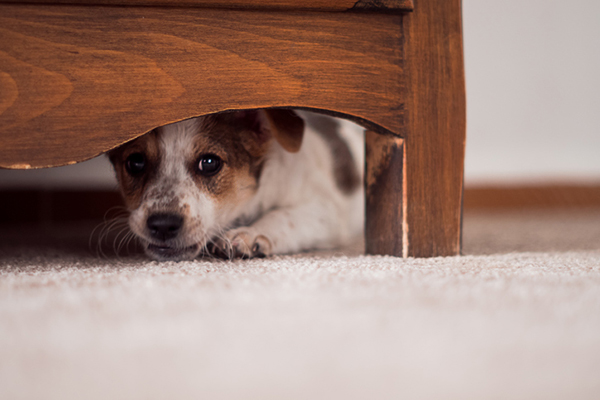Fear is so easy to condition into a puppy, but it is so hard to overcome. Understanding how fear is developed I puppies and more can help us work to prevent it. There are five ways that puppies can develop fearful tendencies. They are:

1. Genetics. Fear is passed on through genetics, from generation to generation. Fearful parents will produce fearful puppies. Breeders should consider wisely before breeding a dog who displays fearful tendencies. Puppy adopting families should meet the parents of the puppy they are adopting. Puppy personalities are molded from their parents.
2. Stress During Pregnancy. If a mother dog is stressed while pregnant she passes along stressful hormones to the pups in utero. These stress hormones effect the puppies and support a heightened state of fear in the pups. Breeders should be conscious to raise pups in a calm, warm and (increasingly) enriching environment. Puppy adopting families should ask questions about where and how the pups where raised.
3. Maternal Behavior. Puppies raised by a fearful mom, a mother dog who is stressed, concerned, or reactive to the environment where they are raising the pups, will pass on this concern and fear to their very impressionable puppies. Breeders should be conscious to raise pups in a calm, warm and (increasingly) enriching environment. Puppy adopting families should ask questions about where and how the pups where raised.
4. Lack of Socialization/Improper Socialization. A puppy who is not socialized, or is not offered socialization opportunities that match their personality type and/or future socialization needs are destined to suffer from fear as they mature into adult dogs. Proper Socialization starts with the breeder and continues on with the family who adopts the puppy. The first 12-16 weeks of a puppy’s life are the most important and crucial socialization and learning time of a dog’s entire life.
5. Experiences That Create Fear and Concern. Painful and scary experiences cause fear. This can be via aversive training methods, improper handling and exposure to new people/situations, or an unplanned and unfortunate incident that causes fear.
Puppies and Adult dogs can display fearful tendencies in four different, or combined ways.
- Flight. Puppies or adult dogs may avoid or move away from situations (including people or other dogs) that they are not comfortable with. Forcing a puppy or adult dog to socialize with someone or something that they are not comfortable with only creates more concern for the puppy, increasing the tendency to be fearful in similar situations in the future.
- Fight. This may include growling, snarling, barking, lunging out at, nipping or even biting. Although Fight related behaviors can be seen in young puppies they are not as common as the other three displays of fear (Flight, Freezing and Fidgeting About). Fight related behaviors often develop as the puppy continues to mature and gain experiences that support the growth of this reaction to fear. Six months of age as well as 2 years of age are critical developmental times for Fight related behaviors to develop and mature.
- Freezing. Freezing is so often missed by people with both puppies and adult dogs. Freezing can be a momentary pause in motion, or it can last for a increased duration of time. As puppies and adult dogs stop moving and pause often many people do not notice the Freeze behavior in context with a fearful situation.
- Fidgeting About. Like Freezing, Fidgeting is again an often missed behavioral response to fear in puppies and adult dogs. It is important to look at the context, situation, in which the Fidgeting behaviors are displayed. Fidgeting can include sniffing at the ground, scratching or licking at themselves, vigorously playing with a toy, drinking water or eating food rapidly.
In puppies these signs of fear are often overlooked. A puppy who does not approach new people but Freezes as a new person comes up to them may not be acknowledged as fearful by its people. A puppy who growls, nips and tries to wiggle away when handled, groomed or picked up may not be acknowledged as fearful by its people. These are just a few examples of behavioral responses to fear that can be missed.
Engaging in a well-designed puppy class can be the difference between early acknowledgement and treatment of fear, as well as learning ways to avoiding fear via learning experiences. It is wise to do your homework and pick a class that is run by someone who is well educated in puppy development, proper socialization methods, as well positive reinforcement based training methods that build trust and confidence.
If your puppy or adult dog is displaying fear, stress, or anxiety related behaviors it is best to contact a well-educated and qualified trainer sooner rather than later. The sooner you start on a path to building confidence, trust and self-security in your puppy, or dog, the happier they, and you, will be.
Want to learn more about fear and how best to treat it? Contact us to today.
